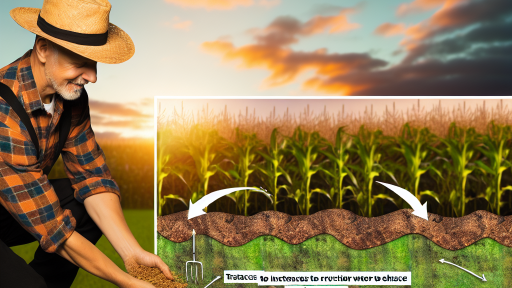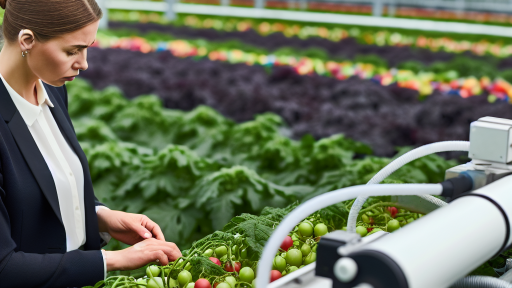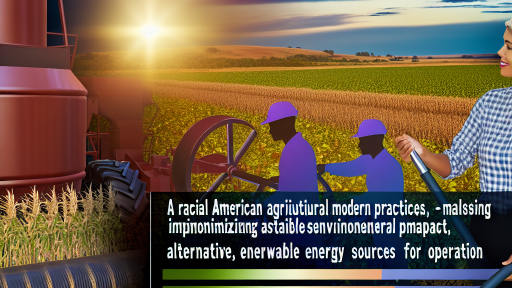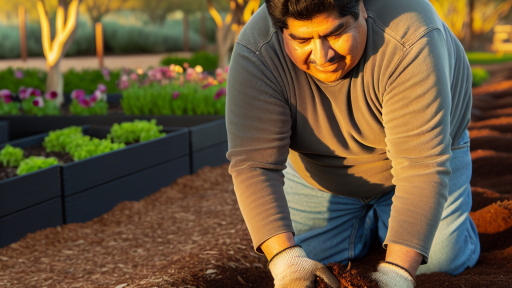Introduction to Mulching
Mulching is a vital practice in farming.
It involves covering the soil with various materials.
Farmers utilize mulch for many beneficial purposes.
One significant advantage is weed suppression.
Moreover, mulch conserves soil moisture effectively.
It regulates soil temperature, ensuring healthier crops.
Additionally, mulching improves soil health over time.
Organic mulches break down, enriching the soil.
This process enhances nutrient availability for plants.
Furthermore, mulch can reduce soil erosion significantly.
It protects crops from harsh weather conditions.
Farmers can choose various materials based on needs.
Diverse options include organic and inorganic materials.
Each type of mulch presents unique benefits and drawbacks.
Thus, understanding these differences is crucial.
Transform Your Agribusiness
Unlock your farm's potential with expert advice tailored to your needs. Get actionable steps that drive real results.
Get StartedFarmers should evaluate their farming practices carefully.
This evaluation helps in selecting the best mulching material.
Mulching offers numerous advantages.
It is essential for sustainable farming practices.
Types of Mulch Materials
Organic Mulch
Organic mulch comes from natural sources such as plant materials.
This type of mulch enriches the soil as it decomposes.
Common organic mulches include straw, wood chips, and grass clippings.
S straw provides excellent coverage and suppresses weeds effectively.
Wood chips offer long-lasting coverage but decompose slowly.
Grass clippings contribute nitrogen to the soil, promoting plant growth.
Additionally, organic mulches improve soil texture and moisture retention.
However, they may attract pests like slugs or insects.
To mitigate this, consider mixing different types of organic mulch.
Inorganic Mulch
Inorganic mulch consists of non-biodegradable materials.
Examples include landscape fabric, gravel, and plastic sheeting.
Plastic sheeting effectively retains soil moisture and prevents weed growth.
Gravel provides excellent drainage and reduces soil erosion.
Landscape fabric allows water and nutrients to reach the soil.
While inorganic mulch does not enrich the soil, it offers consistent coverage.
These materials generally last longer than organic options.
Nevertheless, they can retain heat, which may harm sensitive plants.
To avoid overheating, ensure proper spacing and airflow around plants.
Choosing the Right Mulch for Your Farm
Choosing the right mulch depends on your farming goals.
For soil improvement, organic mulch is often ideal.
Showcase Your Farming Business
Publish your professional farming services profile on our blog for a one-time fee of $200 and reach a dedicated audience of farmers and agribusiness owners.
Publish Your ProfileIf weed control is your primary concern, consider inorganic options.
Your local climate and soil types also influence your selection.
Understanding your specific needs will help you make an informed choice.
Factors to Consider When Choosing Mulch
Soil Type
The soil type on your farm influences your choice of mulch.
Different soils have unique drainage needs.
For instance, sandy soils drain quickly and may benefit from moisture-retaining mulch.
Clay soils, on the other hand, retain water but may not need as much moisture retention.
Consider the nutrient content of your soil as well.
Organic mulches can enrich the soil as they decompose.
Examine your soil’s pH levels to select appropriate mulch.
Acidic soils might benefit from pine needles or wood chips.
Alkaline soils may respond better to straw or grass clippings.
Climate
Your local climate plays a crucial role in mulch selection.
Warm climates can dry out soil quickly. Therefore, use mulch that retains moisture.
In contrast, cooler climates may require mulches that provide insulation.
Furthermore, consider seasonal variations in temperature and precipitation.
In regions with heavy rainfall, choose mulch that will not wash away easily.
Evaluate how mulch interacts with local pests and diseases as well.
Some materials can attract unwanted pests in certain climates.
Always consider the extremes within your climate zone to make the best choice.
Crop Variety
The type of crops you grow affects your mulch choices.
Different crops have varying needs regarding moisture and nutrients.
Vegetables tend to benefit from organic mulches that improve soil health.
Fruiting plants may require specific mulches to enhance growth.
For instance, strawberries often thrive with straw or pine needles around them.
Consider the growth cycle of the crops as well.
Some crops may need more stringent weed control, requiring heavier mulching.
Assess whether your crops are annual or perennial to determine the best approach.
The right mulch helps maximize yields and maintain plant health.
You Might Also Like: Mulching Strategies for Superior Weed Control
Common Organic Mulch Materials
S straw
S straw is a widely used organic mulch material.
It effectively conserves soil moisture and suppresses weeds.
Additionally, straw improves soil structure as it decomposes.
This material is often readily available from local farms.
However, ensure it is free from pesticides or herbicides.
Wood Chips
Wood chips serve as another excellent mulch option.
They provide a natural aesthetic to garden beds.
Moreover, wood chips help regulate soil temperature.
They break down over time, enriching the soil with nutrients.
Mixing different types of wood may enhance their benefits.
Showcase Your Farming Business
Publish your professional farming services profile on our blog for a one-time fee of $200 and reach a dedicated audience of farmers and agribusiness owners.
Publish Your ProfileGrass Clippings
Grass clippings are an abundant resource for many homeowners.
This mulch material is rich in nitrogen, promoting healthy plant growth.
Furthermore, clippings decompose quickly, returning nutrients to the soil.
Be cautious to avoid using clippings from chemically treated lawns.
Layer them thinly to prevent matting and odor issues.
Find Out More: Effective Soil Testing Methods for Farmers
Inorganic Mulch Options
Plastic Mulch
Plastic mulch is popular among farmers due to its effectiveness.
It helps control weeds by blocking sunlight.
Furthermore, plastic mulch retains moisture in the soil.
However, it can heat the soil excessively in hot climates.
Farmers often use black or clear plastic for different benefits.
Black plastic absorbs heat, promoting early plant growth.
Clear plastic traps heat, but it also encourages weed growth.
Recycle plastic mulch to reduce environmental impact.
Landscape Fabric
Landscape fabric offers a more sustainable alternative.
This material allows water and nutrients to permeate while blocking weeds.
It is durable and can last several seasons with proper care.
Install landscape fabric by laying it over prepared soil.
Then, secure it with stakes or mulch.
Additionally, it prevents soil erosion on sloped areas.
However, some crops may struggle to grow through the fabric.
Rubber Mulch
Rubber mulch is made from recycled tires and is becoming increasingly popular.
This material is long-lasting and does not decompose easily.
It provides excellent weed control and moisture retention.
Moreover, rubber mulch improves soil temperature regulation.
Nevertheless, it can be more expensive than other options.
Additionally, it’s essential to ensure proper drainage when using rubber mulch.
Farmers should consider the potential impact on soil health.
Gain More Insights: Integrated Pest Management in Aquaponics
Cost Analysis: Comparing the Expenses of Different Mulch Materials
Overview of Mulch Materials
Mulch materials come in various types, each with its own cost implications.
Common options include wood chips, straw, grass clippings, and shredded leaves.
Understanding these materials helps farmers make informed decisions.
Initial Costs of Different Mulch Types
Wood chips typically have a moderate initial cost.
Straw is usually less expensive than wood chips and widely available.
Grass clippings can be the most cost-effective choice since they are often free.
Shredded leaves might also be free if sourced from local areas.
Long-Term Cost Considerations
While some mulch types are cheaper upfront, they may require more frequent replacement.
Wood chips, for example, break down more slowly and last longer than straw.
Straw can decompose quickly, increasing future purchases.
Grass clippings need regular replenishment but are low in cost.
Showcase Your Farming Business
Publish your professional farming services profile on our blog for a one-time fee of $200 and reach a dedicated audience of farmers and agribusiness owners.
Publish Your ProfileTransportation and Labor Costs
Transportation can significantly influence total mulch expenses.
Purchasing mulch locally can reduce transportation costs.
Furthermore, consider the labor involved in applying different mulch types.
Bulk materials often need more labor for transport and installation.
Return on Investment and Environmental Impact
Evaluate the long-term savings versus the initial investment in mulch.
High-quality mulch reduces weed growth, improving crop yield.
Using organic mulches enhances soil health and fertility over time.
Choosing eco-friendly options may save costs in the long run.
Summary of Key Considerations
- Initial cost varies greatly among different mulch materials.
- Long-term maintenance costs should factor into purchasing decisions.
- Consider transportation and labor expenses.
- Evaluate the potential return on investment for improved yield.
- Environmental impacts could influence mulch material choice.
Gain More Insights: Soil Microbiology: Enhancing Fertility Naturally
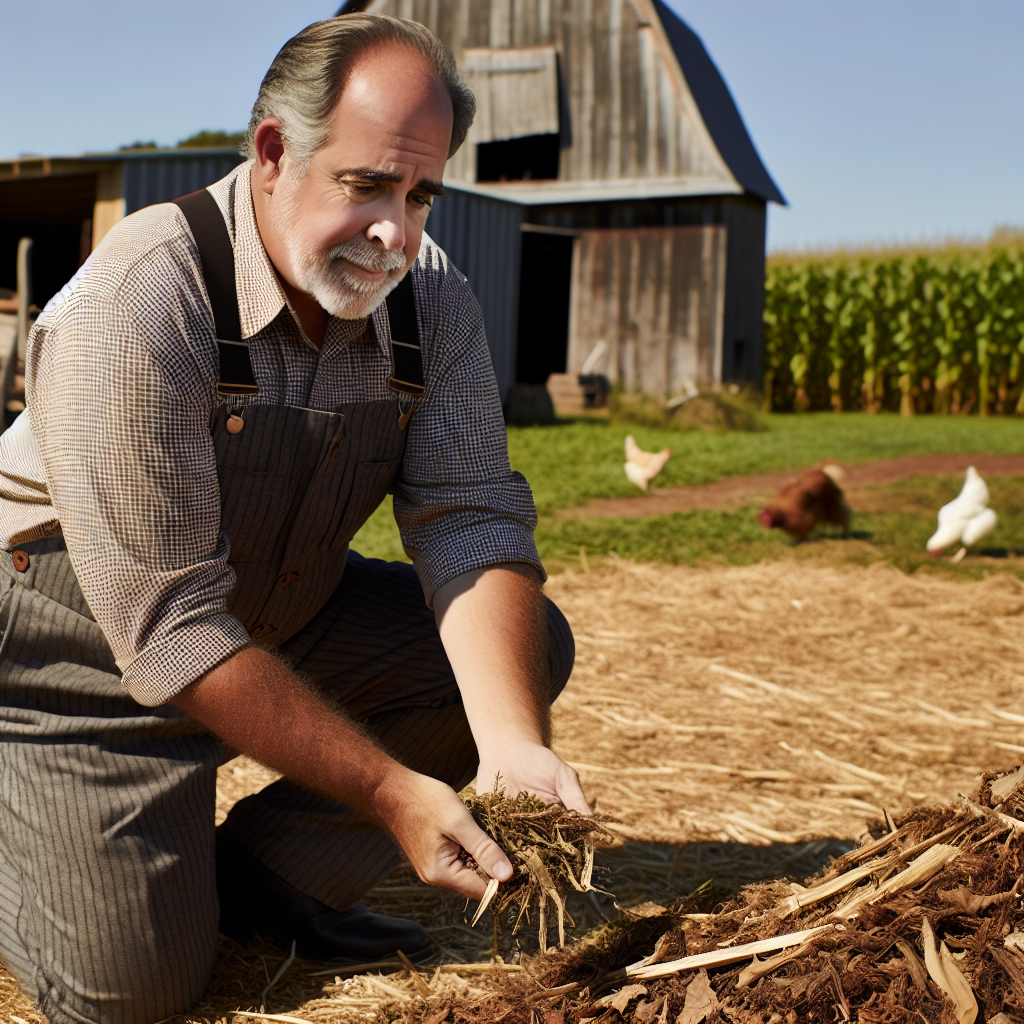
Proper Application Techniques
Preparing the Soil
Begin by clearing the area of weeds and debris.
This step ensures the mulch can effectively suppress weeds.
Next, loosen the soil to promote aeration and drainage.
Consider adding organic matter to enhance soil fertility.
Choosing the Right Mulch Material
Select mulch that suits your specific crops and climate.
Organic options include straw, wood chips, and grass clippings.
Inorganic materials can be rocks or plastic sheeting.
Evaluate the benefits and drawbacks of each choice.
Applying the Mulch
Evenly spread the mulch around plants, avoiding direct contact with stems.
Ensure a depth of two to four inches for optimal results.
It’s crucial to maintain uniform coverage across the area.
Watering After Application
Water the mulch thoroughly to help it settle.
Moisture activates the decomposition process of organic mulch.
Regularly monitor moisture levels in the mulch as it establishes.
Maintaining the Mulch
Inspect the mulch regularly for signs of decomposition.
Replenish mulch as needed to maintain the desired depth.
Remove any weed growth that appears through the mulch layer.
Seasonal Considerations
Adjust your mulch strategy as seasons change.
In winter, consider adding more mulch to protect roots.
During the growing season, monitor moisture and temperature levels.
Maintenance and Longevity: Choosing Mulch That Lasts and How to Refresh It
Understanding Mulch Lifespan
Choosing the right mulch starts with understanding its lifespan.
Diverse materials offer varying longevity when applied to gardens or farms.
Organic mulches, like wood chips, decompose faster than inorganic options.
For instance, straw breaks down within a year, while rocks last indefinitely.
Evaluating Your Mulch Options
When assessing mulch materials, consider your specific needs.
Soft, organic mulches improve soil health as they decompose.
In contrast, inorganic mulches require less frequent replacement.
Choose based on your gardening goals and budget constraints.
Regular Maintenance Practices
To prolong the effectiveness of mulch, establish a maintenance routine.
Start by checking your mulch layer at least once a season.
Look for thinning areas where weeds can sprout and cover crops.
Showcase Your Farming Business
Publish your professional farming services profile on our blog for a one-time fee of $200 and reach a dedicated audience of farmers and agribusiness owners.
Publish Your ProfileReplenishing the mulch prevents weeds and retains soil moisture.
Refreshing Mulch
Refreshing your mulch ensures maximum benefits year after year.
Remove the old, decomposed material before adding fresh mulch.
This practice helps eliminate pests and diseases lurking in the debris.
Utilize high-quality mulch to ensure long-lasting results.
Common Mulch Refreshing Techniques
Employ simple techniques for effective mulch refreshing.
- Add an extra layer of fresh mulch to the existing one.
- Chip and mix old mulch into the soil to enhance nutrients.
- Rotate mulch types seasonally to alter soil health.
- Use landscape fabric to manage mulch degradation.
Implications for Your Garden
Incorporating these maintenance strategies maximizes mulch’s advantages.
Longevity and proper maintenance create healthier growing environments.
Thoughtful choices in mulch selection will pay off for years to come.
Making an Informed Decision for Your Farming Needs
Understanding Your Options
When choosing mulch materials, consider the variety available.
Different types of mulch offer unique benefits.
Some are organic while others are inorganic.
Each type influences soil quality and plant growth differently.
Evaluating Organic Mulch
Organic mulch consists of natural materials.
Common options include wood chips, straw, and leaves.
These materials provide nutrients as they decompose.
Moreover, they improve soil structure over time.
Exploring Inorganic Mulch
Inorganic mulch includes synthetic materials like plastic and rubber.
These products do not decompose, offering long-lasting coverage.
They help retain moisture and suppress weeds effectively.
However, they may not improve soil health like organic varieties.
Considerations for Your Farm Type
Your farm type significantly impacts mulch selection.
For vegetable gardens, organic options are often better.
In contrast, orchards might benefit from either organic or inorganic mulch.
Assess your soil’s needs before making a final choice.
Cost and Availability
Cost is a key factor in selecting mulch materials.
Consider both the initial price and long-term value.
Look for locally sourced materials to reduce expenses.
Availability can also influence your choice.
Environmental Impact
Think about the environmental implications of your choice.
Organic mulch often supports local ecosystems.
In contrast, synthetic materials can contribute to pollution.
Balancing effectiveness with environmental responsibility is crucial.
Discovering Local Resources
Research local suppliers to find quality mulch materials.
Connecting with nearby farmers can offer valuable insights.
Many communities have cooperatives focused on sustainable practices.
Utilizing local resources can enhance your farm’s sustainability.
Additional Resources
Water Conservation in Agriculture – Nevada Irrigation District
What is Syntropic Farming?: A Permaculture Perspective — Porvenir …

